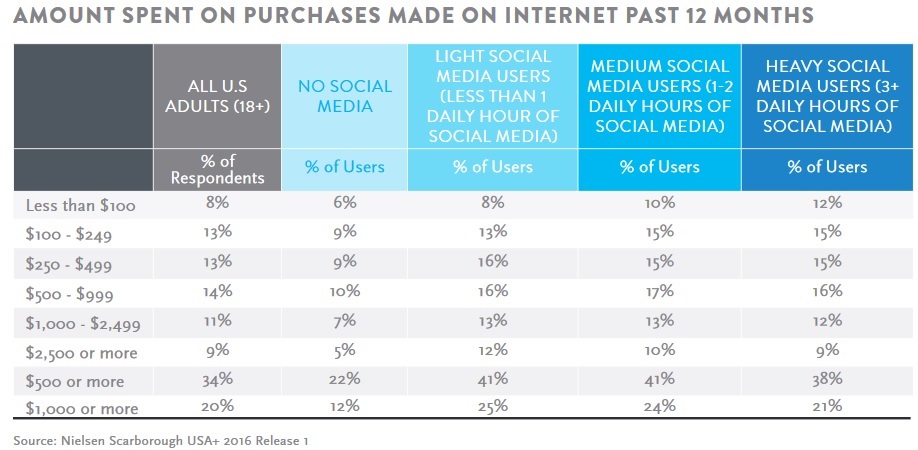Consumers are increasingly flocking to social media and brands are following suite to engage them. Social media is an ideal platform for consumer engagement – brands to see how consumers are using a product. In addition, consumers can read reviews, give feedback, like, share, and comment on branded social media content. Their interactions such as user-generated stories and product reviews are a gold mine for brands. According to the latest Nielsen Social Media Report, over 75% of social media users have, in the last 12 months, made an online purchase. In comparison, 46% of non-social media users made an online purchase in the same period. Regarding amount spent, 22% of non-social users spent over $500 on online purchases over a 12 month period, while 41% of medium social media users spent over $500. An increase in social media usage does not, however, necessarily translate into an increase in the amount spent / consumer engagement. In fact, as the below diagram illustrates, heavy social media users were 50% more likely to spends less than $100 annually than the average U.S. consumer.

Social media consumer engagement includes retweeting, commenting, subscribing, liking, and buying. The most valuable consumer behaviors for brands include sharing a brand’s social media content, mentioning a brand’s name, and online word-of-mouth communication. The value of these behaviors is determined by the size of a person’s social network, the ease of spreading information within this network, and the credibility of the communication.
CREATING AN INTEGRATED CONSUMER ENGAGEMENT STRATEGY
Brands have multiple options to include social media in their marketing programs such as, display advertising, creating native branded content, social media publishing, as well as incorporating user-generated content. Compared to other marketing channels, what makes social media so unique is the participatory nature of the medium – consumers can share their experiences with brands and brands can respond accordingly. Many brands use social media as an integrated component of their consumer engagement marketing strategy.
One example of a brand using an integrated social media strategy is the #myfantaselfie campaign by Fanta & 15min, a Lithuanian news website. To kick-off the campaign, 15min asked Fanta drinkers to submit selfies using the #myfantaselfie hashtag. Instagram posts were curated and featured in a social media stream on the 15min homepage. According to 15min CEO Gabriele Burbiené: “None of our competitors are doing what we’re doing. We are the first to pioneer such interactive campaigns. Crowdynews has allowed us to continue our reputation as cutting edge with news and technology. Furthermore, the Crowdynews filters were as good as they promised and no offensive content made it onto our site. We have the social interaction we want with our readers without having to worry about offensive posts.”
Another example is TUI, the largest leisure, travel, and tourism company in the world, conducted an A/B test with Crowdynews to determine whether user-generated social travel content would improve onsite engagement. In an A/B test they enriched the content of 88 resort listings with geo-tracked Instagram content from in and around their resorts. In other words, TUI wanted to measure potential customer engagement by showcasing guests’ Instagram posts. Engagement metrics from the A/B test proved that the test was successful. Visitors who saw the Crowdynews widget had a higher conversation rate, lower bounce rate, and stayed onsite longer. For more information, download the TUI Conversion & Engagement case study.
AND, CONSUMERS RESPOND
Ashley and Tuten published a study on the creative strategies of top brands. They reviewed the top 100 brands from Interbrand’s Best Global Brands study. Of those brands, 28 were selected because they were recognized for their social media excellence, according to both the Engagementdb report and the Forrester Groundswell Awards.
When incorporating social media into advertising campaigns, top brands use a variety of consumer engagement messaging strategies. The top three appeals brands used were:
- 89% functional appeal, the utility or functionality of the product or service.
- 68% resonance, reflecting a person’s values and interests
- 57% experiential appeal, how consumers will experience a product, its sight, sound, taste, touch, smells.
User-generated content is of great value for brands as illustrated by the fact that a high number of brands call for consumers to submit personal content. Twenty-six out of 28 brands asked users to comment, answer questions, or share a story, photo, or video. Fourteen out of 28 brands provided an incentive for feedback and ten out of 28 brands asked consumers to give feedback or rank the user-generated content of others.
In summary, how are brands’ creative strategies related to social media / consumer engagement? Appealing to consumers who are familiar with a brand’s products and then incentivising them to share content is proven to increase brand engagement. Interestingly, in this age of clickbait where publishers use sensationalist headlines to engage readers, an appeal to people’s emotions seems to backfire for brands. The correlation between a brand’s emotional appeal and their engagement score was negative, which suggests that brands with high engagement do not appeal to on an emotional level.
Sign-up for a free Crowdynews demo to learn how you can include user-generated content in a marketing campaign.
